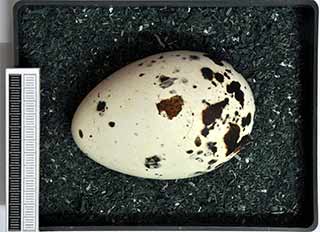Razorbill (Alca Torda)
The French call it Petit pengouin. In fact the Razorbill looks like the smaller copy of a penguin. Other names attributed to the Razorbill are Razor-billed Auk or Lesser Auk. The Razorbill belongs to the Atlantic Auks which are also named "penguins of the northern hemisphere".
White breast, belly and legs, dark black back, wings, tail and head, and dark eyes on top of it. The wings are short and narrow and it seems as if the bird would never make it into flight and up in the air. Trust me, they fly. White on the bill give the bird a distinctive appearane.
Geographical Variations
There are two subspecies existing and distributed over the entire distribution area:
- Alca torda torda Linnaeus 1758 - distributed in the arctic, Baltic Sea, White Seas, Norway, Bear Island, Iceland, Greenland, eastern North America
- Alca torda islandica C.L. Brehm 1831 - distributed in Ireland, Great Britain, northwest France - this species has smaller wings and is generally lighter than torda.

Description - Characteristics: Razorbill
Breeding – Clutch – Measurements – Habitat – Diet - Threats
Taxonomy:
Order: Charadriiformes
Family: Alcidae
Genus: Alca
Species: Razorbill
Scientific Name: Alca torda
Names and Synonyms of the Razorbill
Name in German: Tordalk
Name in Czech: Alka malá
Name in Slovak: Alka vrúbkozobá
Name in Hungarian: Alka
Name in Croat: Oštrokljuna njorka
Name in French: Petit Pingouin
Name in Spanish: Alca Común
Name in Portuguese: Torda-mergulheira
Name in Dutch: Alk
Name in Italian: Gazza marina
Name in Iceland: Álka
Name in Faroer: Álka, Nakkalanga
Name in Greenland: Apparluk
Name in North Sami: Hálkka
Name in Finnish: Ruokki
Name in Danish: Alk
Name in Swedish: Tordmule
Name in Polish: Alka
Name in Russian: Гагарка
Distribution – Movements – Habitat - Behaviour
Distribution: The penguins of the northern hemisphere; North Atlantic and shorelines ov Canada, New England, from West Greenland to northwest France, North Sea and Baltics; White Sea in the northeast; Bear Island.
Movements: Migratory, spent most of the time out on the Atlantic.
Wintering: shores of Great Britain and Ireland, south Sweden, south Norway, Baltic Sea, Denmark, Atlantic coast of France, Spain and Portugal and further south to Morocco; torda mainly winters in the breeding areas.
Habitat: Spents most of the year out on the ocean, on shores, offshore in winter, colonial on cliffs and rocky islands.
Behaviour: Activity during daytime and at twilight. Flies close to water surface. Dives ony a few metres deep. Mostly gregarious.
Field Characteristics: Big head, short neck, high and slender bill with perpendicular white line close to centre of bill. Relatively large pointed tail. Black plumage, back and wings and dark eyes, white chest, belly and undertail coverts, white feather tips at secondaries. White line from upper bill to eye.
Bill: black.
Tarsus: Black.
Iris: dark-brown.
Measurements
Size: 37-39 cm
Weight: 524-890 g
372-645 g (islandica)
Wingspan: 63-68 cm
Wing: 20.1-21.6 cm
18.7-20.0 cm (islandica)
Voice: Deep aarh.

Clutch: 1 egg
Eggs: long-oval, base colour white to brown or greenish, with variety in stains.
Egg Measurements:
Length: 64.4-84.2 mm
Width: 41.0-52.0 mm
Ø: 75.3x48.0 mm (n=167)
Egg weight: 80.0-107.0 g (n=92)
shell weight: 6.5-12.7 g; Ø = 8.7 g (n=250)
Recurrent Clutch: mainly another egg is layed within the first 18 days after loss; even two clutches are possible.
Incubation: 28-43 days, Ø 36 days; both parents share the task of incubating.
Hatching: It takes 48-90 hours (Ø 72±16 hours) from first crack in the shell to the chicken fully free of the shell.
Fledging: Depends on geographical area: 14-22 days (Ø 17-18 days) in boreal zones, 19-22 days in subarctic zones. Both parents feed the juvenile. Juveniles jump off cliff ledges after 14-22 days, parents lead juveniles to the ocean where they swim for quite a while before finally fledging.
Dependency: After jumping off the cliffs juveniles are dependent on their parents for several weeks.
Miscellaneous
Food: pelagic fish, sprats, sandeels, gobiidae; herring in winter; also sticklebacks and crustaceans.
Longevity: Oldest known ringed bird of a Razorbill reached an age of 30 years and 1 months.
Mortality: Adults are subjected to a mortality rate of 8-10% per annum; the mortality rate for immatures is c. 62%.
Threats: Currently large losses of individuals through oil pollution, drowning in fishing nets and high levels of pollution. Hunting is no longer the main threat, if any then locally.
